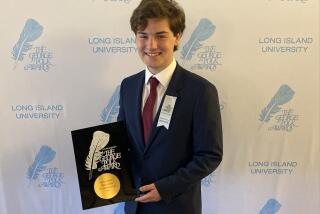Clifford Nass dies at 55; sociologist warned against multitasking
- Share via
When Clifford Nass moved to a Stanford University freshman residence hall as a “dorm dad” in 2007, he wasn’t quite prepared for college life in the 21st century. Even as a professor who for decades had studied the interaction of humans and computers, he was caught off-guard when one of his students explained why she was texting her boyfriend just down the hall.
“It’s more efficient,” she said.
Then there was a familiar sight Nass continued to find astonishing. In lounges, in libraries, just about everywhere, he gazed at a legion of the perennially plugged-in: They chatted on cellphones, scanned Facebook, watched videos, blasted out tweets, and maybe even thumbed through a calculus text or a history of the modern world, all at once.
“I thought: Wow, that’s pretty awesome,” he told the Boston Globe in 2011. “What do they know that I don’t know, and how can I be like that?”
The answers surprised him.
Nass, a sociologist who was among the first academics to sound alarms about the dangers of chronic multitasking and the decline in the kind of face-to-face interactions that he so unabashedly enjoyed with students and colleagues, died Saturday at Stanford Sierra Camp near South Lake Tahoe. He was 55.
Nass collapsed after a hike, the university said.
After several years of studies, Nass and other Stanford researchers came to some disturbing conclusions. They found that the heaviest multitaskers — those who invariably said they could focus like laser beams whenever they wanted — were terrible at various cognitive chores like organizing information, switching between tasks and discerning significance.
“They’re suckers for irrelevancy,” he said. “Everything distracts them.”
More worrisome to Nass was his finding that people who regularly jumped into four or more information streams had a tougher time concentrating on just one thing even when they weren’t multitasking. By his estimate, “the top 25%” of Stanford’s students were in that category.
In a 2011 lecture at the university, Nass said writing samples from freshman multitaskers showed a tendency toward shorter sentences and disconnected paragraphs.
“We see less complex ideas,” he said. “They’re living and writing in a staccato world.”
Over the years, “most academics, including myself, kept seeing it as an aberration,” he told PBS’ “Frontline” in 2009. “You’d see someone multitasking and go, ‘Ha ha ha, those wacky college kids — OK, they’ll grow out of it.’ And then you start looking around and go, ‘Wait a minute, they’re growing into it, not out of it.’ Little kids are growing up with it. Older people are being stuck with it.”
“We could essentially be undermining the thinking ability of our society,” he said. “We could essentially be dumbing down the world.”
Nass’ research struck a chord with parents worried about their media-hungry children and workers swamped in emails they were expected to answer immediately. He also did widely publicized work on the computerized voices and digital screens that can either drive motorists crazy or make them a little safer.
“He was on the leading edge of a dialogue society is going to have on when technology is appropriate and when it’s too much,” said David Strayer, a University of Utah neuroscientist and an expert on distracted driving. “His work will only gain in prominence because society is becoming that much more technological.”
A professor at Stanford since 1986, Nass, rumpled and genial, was a campus favorite, a Mr. Chips of the digital age.
“He was the caring, lovable professor with his shirt untucked and a piece of breakfast on his sweater, running across the room to say hello and tell you about something new he had figured out in the lab,” said Reilly P. Brennan, executive director of Stanford’s Revs automotive program.
Nass was the program’s director, as well as director of the university’s Communications between Humans and Interactive Media lab, and co-director of the Center for Automotive Research at Stanford.
“He had two cars,” Brennan said in an email. “One was an old Volvo and the other was an older Volvo, each littered with bags of McDonald’s, PhD theses, receipts from his favorite café in Palo Alto that he should have turned into me, and notes about where the future was headed.”
Born in Jersey City, N.J., on April 3, 1958, Nass grew up in Teaneck, N.J., and graduated from Princeton University in 1981 with a bachelor’s degree in mathematics. He stayed at Princeton and, in 1986, received his doctorate in sociology.
Married in 1989 and divorced, he is survived by his son Matthew.
In addition to teaching, he was a consultant for numerous technology companies and wrote three books.
Published in 2010, his latest — “The Man Who Lied to His Laptop” — explores a theme he elaborated in many of his research studies: For better or worse, people view their devices as if they were people. They’ll feel good if computers flatter them, Nass wrote, detailing experiments he conducted in his Stanford lab.
And if the voice on a car’s navigation system — as obviously synthetic as it is — rubs drivers the wrong way, they’ll get angry. In the late 1990s, BMW had to recall its 5 Series cars in Germany; men were complaining, Nass wrote, because the “voice” was female.
Whether people can master their feelings toward machines is an open question, he told NPR earlier this year.
“As a psychologist, I’m extremely optimistic,” he said. “As a communications scholar who knows how seductive media is … it’s a tough call.”
More to Read
Start your day right
Sign up for Essential California for the L.A. Times biggest news, features and recommendations in your inbox six days a week.
You may occasionally receive promotional content from the Los Angeles Times.







